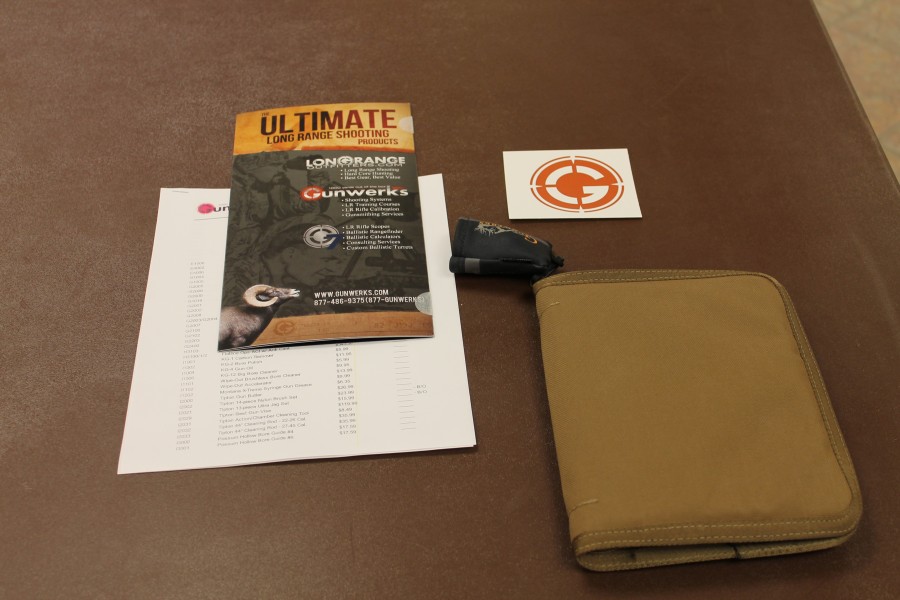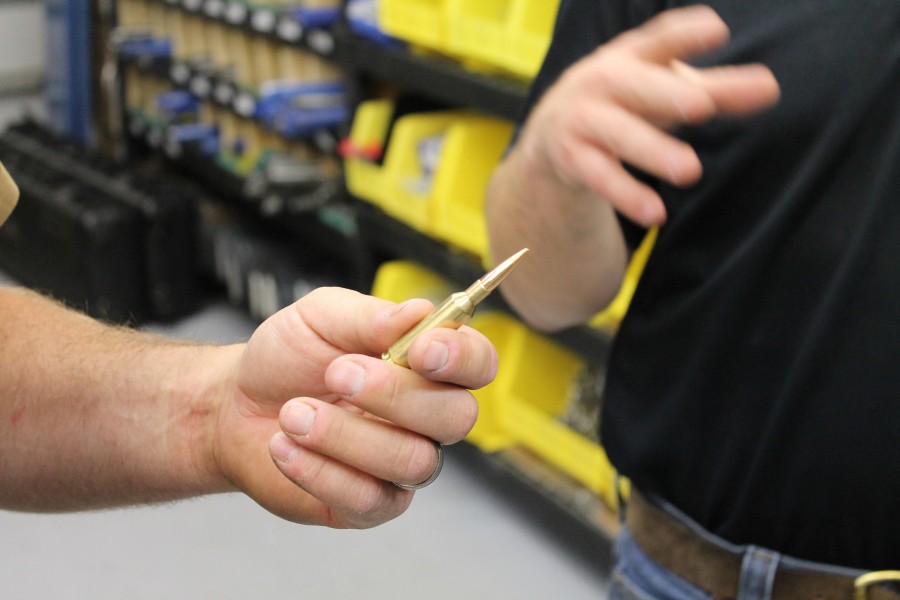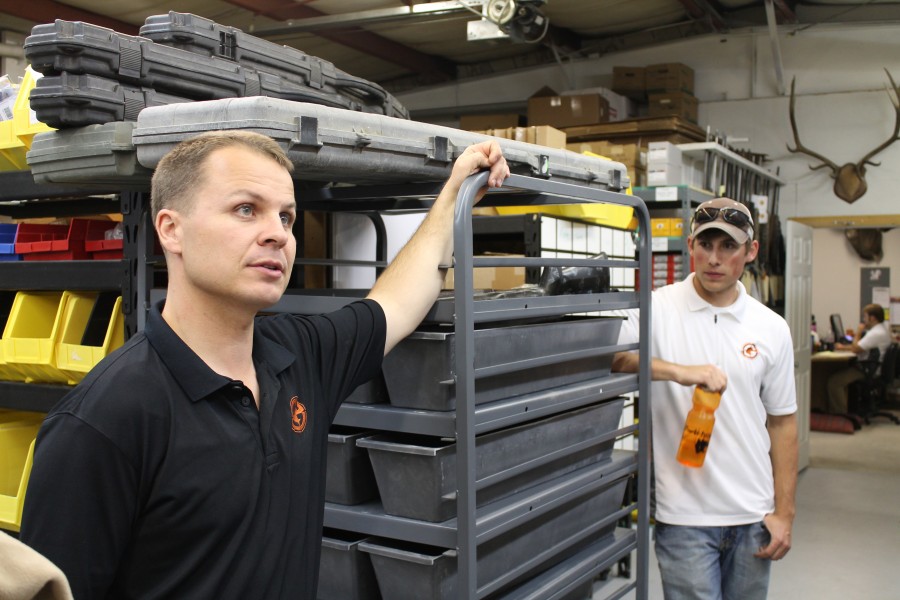Getting to Burlington, WY, Gunwerks HQ, is no easy task. I thought I was somewhat remote in Cody, WY, but 37 miles to the East; it gets a little more desolate. And I think that’s the way Aaron Davidson likes it. Before class kicked off, my class of 10 talked with him about how remote things are in Burlington. Aaron grew up here, his family is here, and this is what he knows. He told us that recruiting talent is hard, but that means that only the most committed make up the workforce of seventeen. A quick bit of trivia, Gunwerks is the largest private sector employer in Burlington. They would be the largest employer if it weren’t for that pesky school a quarter of a mile down the road . . .
Our first classroom session kicked off promptly at 9:00 AM. Aaron spent a few brief minutes talking about the growth of Long Range Hunting (LRH) and how he’s seen things evolve. He admits that LRH is still very much a niche, but it is gaining ground. Modern ballistics have accelerated in the last few decades and there is much less “art” and a lot more science.
But Aaron’s biggest message to our class was about ethics. It is easy to buy your way into high-end gear (more on that later), and start flinging lead downrange. Unfortunately, it is WAY easy to get in over your head and start making less than ethical shots. To Aaron, it boils down to three things. First, understand your equipment, second, understand the environment you are operating in, and third, understand your limitations.
Two days of class in Wyoming does not the long-range hunter make. This is a primer on what you need to know, and the opportunity to start cracking shots under the watchful eyes of a group of guys who do this for a living. I took about eight pages of notes during our three-hour classroom session, and while I could definitely regurgitate it here, I won’t.
First, I don’t want to steal Aaron’s thunder. He’s written a lot about the topics covered in Day 1 on his website gseven.com. Sit down with a cup of coffee and read through. The second reason for brevity is to avoid an article that would rival something out of Bruce Kraft’s wildest dreams (and Dan’s nightmares). Instead, I’ll give you a quick blurb on the topics we covered with the high points. Even then, this is a bit of a read. Suffice to say that I am WAY impressed after one day of class. If you are at all interested in stepping out past 500 yards, this class is a must.
Bullet Selection
Much like the never ending self defense arguments about .45 vs. 9 mm, LRH is all about bullet placement. All the controlled expansion, penetration, and energy means jack if you can’t hit what you aim at. Being able to place a bullet where you want it is the first priority. Bullets need to be consistent and repeatable. Once they get there accurately, they need to create an adequate wound channel.
External Ballistics
Long range shooting is fundamentally about controlling drop and compensating for wind. The first is a function of gravity and drag. We can calculate drop very easily with any number of tools. Register with Gunwerks and you can use theirs to do so. The second part of drop is based on ballistic coefficient, which is just a mathematical representation of drag.
On that note, BC was one of the topics I learned the most about. Simply put, BC is based on bullet shape, weight, and cross-sectional area. Most of the published BC numbers are based on the G1 model. However, there is no standardization among manufacturers when it comes to BC numbers. Since BC is the inverse of the coefficient of drag, it is a changing number based on velocity. Most manufacturers produce a BC number based on typical velocities, but they don’t standardize on the atmospheric factors during testing. Short story, your mileage might vary, see what works best in your rig.
Wind correction is based on ballistic coefficient, environment, and wind speed. Luckily, compensation for wind is on a linear scale. Your hold for a 5 mph wind is half what it would be for a 10 mph wind.
At the end of the day, if you are serious about LRH, you have to do an external validation of the trajectory of your particular load under normal operating conditions. What separates Gunwerks from other gun manufacturers is the validation that goes on after they actually construct the gun. Each gun will have a custom ballistic profile worked up. This is based on real world data collected at their private range.
Reticles & Compensation
We switched gears at this point to talk about the two major reticles on the market and how to use them for compensation. Ballistic Drop Compensation (BDC) and MOA are going to be the two most popular. BDC reticles are quite a bit quicker for handling elevation and wind, but are prone to error induced by environmental conditions and load development. It is hard to swap out reticles, so once you get one, you have to commit to that setup. Change elevation? Use a heavier bullet? Too bad. MOA will allow you to create tables based on environment and load data that will correspond with turret adjustments on your scope. The drawback is that it can be slow and click values will correspond with oddball distance measurements. Both have their place and as I found, there is a nice middle ground.
Once you have a validated ballistic profile, you need to be able to compensate for distance and wind. The Gunwerks crew uses knob adjustment for elevation and holds for the wind. Specifically, Aaron uses a BDC turret, which shows a turret mark corresponding to known distances. See pictures for what that looks like. In the field, you adjust your elevation with the turret and then hold based on wind. In the practical setting this is a very efficient blend that minimizes time goofing with tables, knobs, and dials.
Terminal Ballistics
Once you do the math, and squeeze the trigger, the bullet has to be able to do work once it gets to the animal. To kill an animal, we need to stop the blood from going round and round or the air from going in and out. This necessitates creating a wide enough, deep enough hole to bleed from. All bullets work, just differently. I’ll spare you the brain fade, but we spent a good amount of time comparing penetrating, expanding, and VLD bullets. Those wanting more will enjoy this.
Velocity
Simply put, consistent penetration can only happen above 2000 fps. Below that, penetration becomes incredibly inconsistent. The body of work supporting that statement comes from “Shooting Holes in Wounding Theories”. It is truly a riveting read. For years, hunters have relied on energy as the golden standard for selecting the correct load. According to Aaron, the two most important factors are velocity and bullet construction.
Shot Placement
The best bullet in the world means nothing without good shot placement. We need to anchor the animal to the ground with one shot. Worse case scenario, we don’t make a kill on the first shot. If he’s down hard, we can take a second to end things ethically. As best I could glean from class, a high shoulder shot does this best. This shot allows wind induced horizontal errors to have less of an effect on kill success by giving you room to work on the lungs as well as spine without having to mess with that bony shoulder. If you miss low, it is still a heart shot. And if you miss high, you can sometimes get a second shot because you didn’t kick up dirt in front of the animal. Nearly everyone in the class had a story about a shot that went high that didn’t spook the animal allowing them to make a better second shot.
Cartridge selection
A couple of the .30 cal guys in the class started to shift nervously when Aaron opened this section by saying that he was about to bash the .30. According to Aaron, .30 cal is not an optimal long range round. Because of its larger cross sectional area, it requires higher initial velocities to overcome drag. Remember that cross sectional area was a component of BC. The old school method was to pack more powder behind a suitably large projectile. The “intelligent” method is to look for high BC bullets that lose less velocity to drag. This translates to less recoil, and bullets with a longer effective range. What’s not to love about that?
Barrel Timing
Recoil acting on shooter creates torque, which sets off harmonic vibration in the barrel. This torque can be minimized in two ways. The first is to create a smaller moment arm for recoil to act against by creating more efficient stocks. The second is to lower recoil (see above on which cartridges do that). After that work has been done, the shooter can create a load that is consistent and works with the harmonics of the barrel to get maximum accuracy.
Final Thoughts
As you have probably gleaned, Day 1 was a jam-packed three-hour class. I was mentally exhausted before we even headed to the range. However, I can confidently say that I learned more in three hours with Aaron than I could have in a year of research and time at the range. He’s clearly a guy who is passionate about what he does. It also helps that he’s probably forgotten more about LRH than I’ll ever know. Day 2 should bring a focus on dealing with the wind. Stay tuned for more.










Excellent article. Thanks, Tyler.
800+ yards out to the 4 digit numbers.
How far do they consider long range hunting?
Tyler, what sort of ranges are we talking about here? 400 plus yards? 600 plus yards? 800 plus yards?
Is he a big fan of standard long range cartridges such as the 22-250 or the .270 or is he a fan of magnums?
Thanks for the great read, and have fun!
JR, I agree with your question, it was mine also. What is the caliber of choice for long range? I have the rifles that JR mentioned, 270, 22-250 but would a 300 win mag be a good choice also?
I’ve been thinking something like a .270 WSM would be an ideal long range hunting round. Maybe I was on to something.
I was in total agreement until the part about penetration being unreliable at 2000 FPS. I’m not sure if you meant to say expansion instead, which can become inconsistent below 1800-2000 FPS for some highly aerodynamic bullets.
A 168 grain bullet at 2000 FPS is still carrying just under 1500 foot pounds. I understand, based upon your statement, that energy was not emphasized in the class. However, 2000 FPS out of 168 grains is quite similar to a .308 at 300 to 400 yards, and is certainly enough punch for deer sized game like whitetail. I say that because I’ve successfully shot deer at that distance, with very similar bullet weights, and the bullets achieved expansion. I basing that upon the exit holes on the deer, and the meat in the freezer.
Excellent job on the article, by the way, and thanks for sharing.
I’m starting to want to write an article myself.
I did a poor job of wording it. Reliable expansion is the much better way to express it. From that study, you can see a wide variation below 2000 fps. Some bullets won’t expand and will penetrate deep, others will and won’t go deep at all.
Word. That seems the most succinct way to say it.
So what was the cartridge suggested in the end. i will take the time to read the jump points but figured I would just ask too. 🙂
I feel like a kid that didn’t get to go on the field trip!
From what I can see, it’s a 7mm Mag (possible a Remington), loaded with 168 grain VLD (possibly Berger) with a claimed ballistic coefficient of .617.
drool… 🙂
Here in Wyoming, Cody isn’t remote. It’s a Big Town[tm], with stoplights, parallel parking and everythin’.
I remember back in the 1990’s I think at there was a short lived fad with extra long barreled bolt action rifles to maximize velocity for long range hunting. These guys were putting 26″ to 30 ” long barrels on their guns and the nick name for these guns was “bean rifles” as they got used a lot hunting on the huge soybean fields of the prarie states. Any mention of this in your class?
One of your best yet Dude, keep ’em coming…
STATING WIND CORRECTION IS LINEAR IS AN OVERSIMPLIFICATION. LONG DISTANCE WIND HOLD INCREASE FLIGHT TIME AND DISTANCE…THOSE HOLD OVER RETICULES SHOULD BE DOWN CURVING PARABOLIC AT THE ENDS FOR LONGER DISTANCES. FOR A FAST SLICK BULLET AT 1200 OR LESS WITH A WIND OF 10 OR LESS HORIZONTAL IS AN ADEQUATE APPROXIMATION BUT I WOULD ARGUE EVEN THE HORIS RETICULES ARE WRONG IN NOT CURVING DOWNWARD AT THE ENDS BEYOND 1200
Comments are closed.